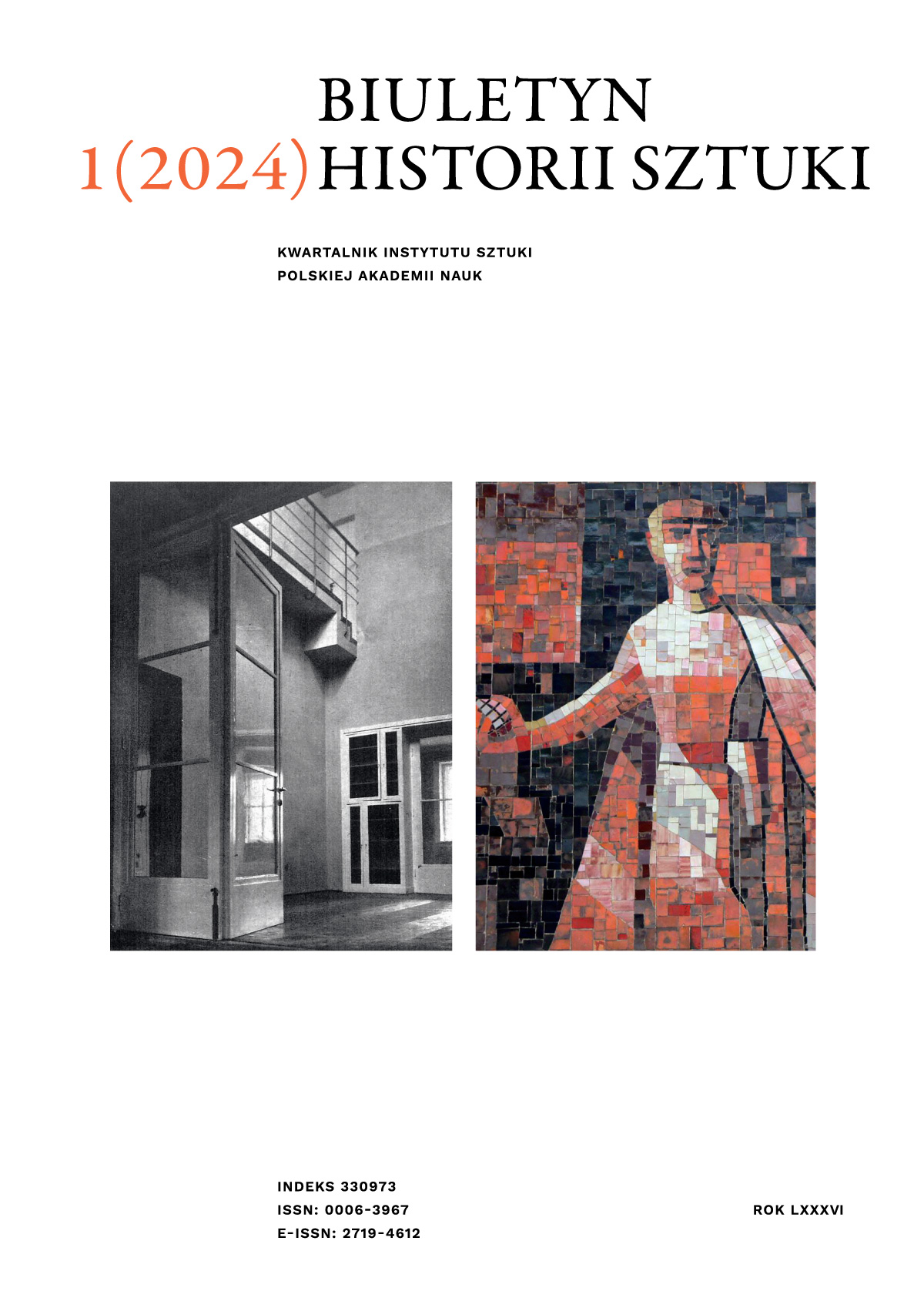The Kilim Rug Design at the School of Decorative Arts and Artistic Industry in Cracow during the Inter-War Period
Agata Wójcik
agata.wojcik@up.krakow.plUniversity of the National Education Commission, Krakow (Poland)
https://orcid.org/0000-0003-2464-660X
Abstract
The article contains a discussion of the activity of the kilim rug design atelier at the Textile Department (Weaving Department) of the State School of Decorative Arts and Artistic Industry in Cracow (State Institute for Fine Arts). It analyses the kilim-making course curriculum, demonstrates how students gained practical training in this field, states the characteristics of the students’ work, determines the concept of a kilim as adopted at the Cracow school, and discusses the ways in which the kilim-making atelier was promoted. In addition, the article traces the connections of the State School of Decorative Arts and Artistic Industry in Cracow with other kilim-making ateliers, as well as with other schools training students in this field. Another area of interest are the further professional paths of the graduates. The most essential source of knowledge about the kilim rug design at the Cracow school are the archival materials held in the Central Archives of Modern Records in Warsaw, the National Archives in Cracow and the Archives of the Academy of Fine Arts in Cracow. Designs by the students of the State School of Decorative Arts and Artistic Industry are known owing to the designs themselves and their photographs held in the collections of the Jagiellonian University Museum, the National Museum in Cracow, the Historical Museum of the City of Cracow, the Central Museum of Textiles in Łódź, and the National Digital Archive. Szkoła Sztuk Zdobniczych i Przemysłu Artystycznego w Krakowie, Państwowy Instytut Sztuk Plastycznych w Krakowie, kilim, tkanina, projektowanie, polskie rzemiosło artystyczne dwudziestolecia międzywojennego, polskie szkolnictwo artystyczne dwudziestolecia międzywojennego.
Keywords:
School of Decorative Arts and Artistic Industry in Cracow, State Institute for Fine Arts in Cracow, kilim rug, fabric, design, artistic crafts in Poland in the inter-war period, art education in Poland in the inter-war periodReferences
Jurga, Halina. „Kilim polski”. Rozprawa doktorska, Instytut Sztuki PAN, 1998.
Google Scholar
Jurga, Halina. „Kilimy, gobeliny, dywany”. W: Spółdzielnia Artystów „Ład” 1926–1996, redakcja Anna Frąckiewicz, 154–169. Warszawa: Muzeum Akademii Sztuk Pięknych, 1998.
Google Scholar
Kilijańska, Alicja. „Staatliche Kunstgewerbeschule 1939–1943”. W: Kunstgewerbeschule 1939–1945 i Podziemny Teatr Niezależny Tadeusza Kantora w latach 1942–1944, redakcja Józef Chrobak, Katarzyna Ramut, Tomasz Tomaszewski, Marek Wilk, 49–66. Kraków: Cricoteka, 2007.
Google Scholar
Korduba, Piotr. „Wystawa tkanin «Polska sztuka tkacka» w Instytucie Propagandy Sztuki w 1938 roku”. W: Tkaniny orientalne w Polsce – gust czy tradycja? Konferencja Polskiego Stowarzyszenia Sztuki Orientu, redakcja Beata Biedrońska-Słotowa, 23–32. Warszawa: DiG, 2011.
Google Scholar
Krawczyk, Jerzy. „W cieniu Akademii Sztuk Pięknych. Od Oddziału Przemysłowego Artystycznego Państwowej Szkoły Przemysłowej do Państwowej Szkoły Przemysłu Artystycznego w Krakowie (1891–1921)”. Małopolska. Regiony – Regionalizmy – Małe Ojczyzny 23 (2021): 9–34.
Google Scholar
Krawczyk, Jerzy. „W cieniu Akademii Sztuk Pięknych. Od Państwowej Szkoły Przemysłu Artystycznego do Państwowej Wyższej Szkoły Sztuk Plastycznych w Krakowie (1921–1950)”. Małopolska. Regiony – Regionalizmy – Małe Ojczyzny 24 (2022): 39–86.
Google Scholar
Mulczyński, Jarosław. Poznańska zdobnicza. Historia Państwowej Szkoły Sztuk Zdobniczych i Przemysłu Artystycznego w Poznaniu w latach 1919–1939. Poznań: Akademia Sztuk Pięknych, 2009.
Google Scholar
Paś, Monika. „Echa sztuki art déco w projektach krakowskiego stowarzyszenia Atelier Tekstylne”. W: Polskie art déco. Materiały szóstej sesji naukowej „Polskie art déco. Wnętrza mieszkalne”, redakcja Zbigniew Cholewiński, 202–218. Płock: Muzeum Mazowieckie, 2017.
Google Scholar
Sztuka wszędzie. Akademia Sztuk Pięknych w Warszawie 1904–1944. Redakcja Jola Gola, Maryla Sitkowska, Agnieszka Szewczyk. Warszawa: Akademia Sztuk Pięknych, 2012.
Google Scholar
Warsztaty Krakowskie 1913–1926. Redakcja Maria Dziedzic. Kraków: Akademia Sztuk Pięknych, 2009.
Google Scholar
Authors
Agata Wójcikagata.wojcik@up.krakow.pl
University of the National Education Commission, Krakow Poland
https://orcid.org/0000-0003-2464-660X
Agata Wójcik is a doctor in Humanistic Sciences, in the discipline of Studies on Arts (Faculty of History, Jagiellonian University, 2013), currently an assistant profesor at the Institute of Art and Design of the University of the National Education Commission in Cracow; she is the author of, among others, the book Towarzystwo Polska Sztuka Stosowana (2022) and studies on interior decoration and furniture design in the early 20th century.
Statistics
Abstract views: 345PDF downloads: 252
License
Copyright (c) 2025 Agata Wójcik

This work is licensed under a Creative Commons Attribution 4.0 International License.
The author grants the publisher a royalty-free non-exclusive licence (CC BY 4.0) to use the article in Biuletyn Historii Sztuki, retains full copyright, and agrees to identify the work as first having been published in Biuletyn Historii Sztuki should it be published or used again (download licence agreement). The journal is published under the CC BY 4.0 licence. By submitting an article, the author agrees to make it available under this licence.
In issues from 1(2019) to 4(2022) all articles were published under the CC BY-NC-ND 4.0 licence. During this period the authors granted the publisher a royalty-free non-exclusive licence (CC BY-ND 4.0) to use their article in Biuletyn Historii Sztuki, retained full copyright, and agreed to identify the work as first having been published in our journal should it be published or used again.
Most read articles by the same author(s)
- Agata Wójcik, ‘Warsaw Has Never Seen Anything Like It’. Exhibition of the Society of Polish Applied Art at the Warsaw Zachęta in 1908 , Biuletyn Historii Sztuki: Vol. 81 No. 2 (2019)
- Agata Wójcik, The Designer Julian Pietrzyk and his Cooperation with the Artistic Furniture Factory of Szczepan Łojek , Biuletyn Historii Sztuki: Vol. 86 No. 2 (2024)






